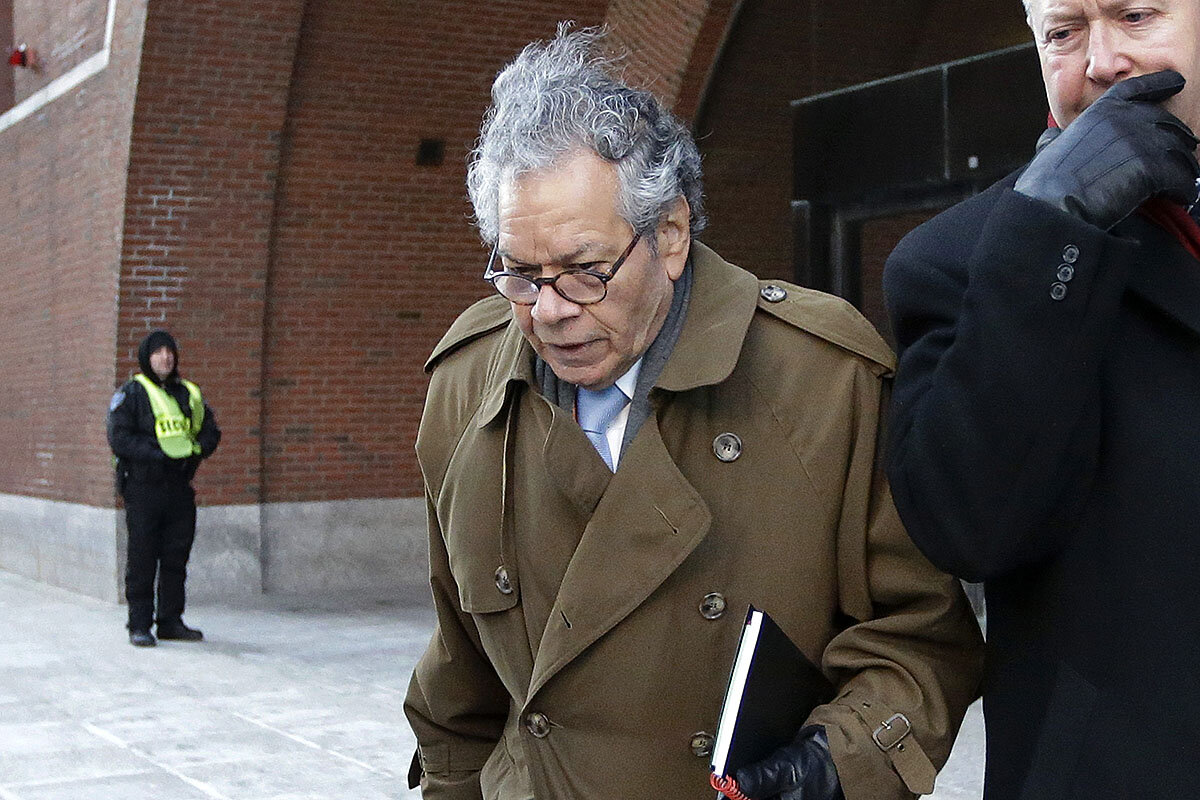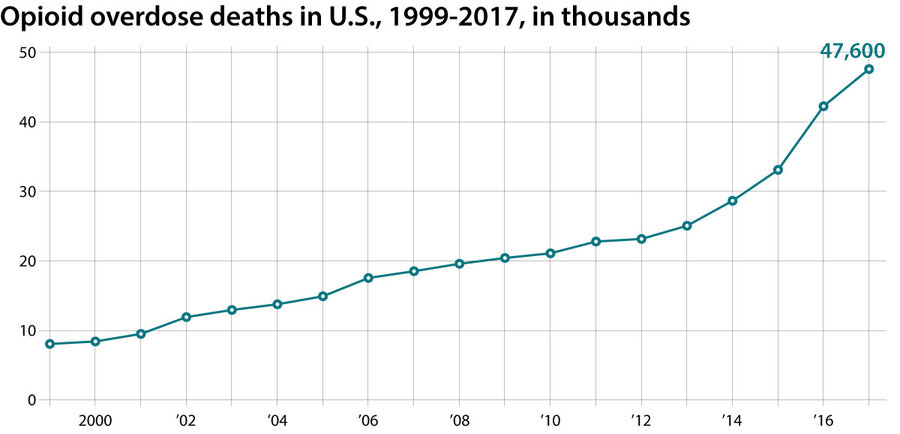What equals justice for opioid crisis: Help victims or punish Big Pharma?
| Boston; and Austin, Texas
As hundreds of lawsuits against opioid manufacturers, distributors, and retailers chug through the U.S. legal system, a trio of recent decisions gives a hint of what may be coming.
On May 2, a Boston jury convicted the onetime billionaire CEO of Insys Therapeutics and four former executives on racketeering charges, in connection with bribing doctors to prescribe opioid medication to patients who didn’t need it and deceiving insurers into paying for it.
“Today’s convictions mark the first successful prosecution of top pharmaceutical executives for crimes related to the illicit marketing and prescribing of opioids,” said United States Attorney Andrew E. Lelling in a statement. “Just as we would street-level drug dealers, we will hold pharmaceutical executives responsible for fueling the opioid epidemic by recklessly and illegally distributing these drugs, especially while conspiring to commit racketeering along the way.”
Why We Wrote This
Three recent developments in lawsuits against opioid manufacturers and distributors point to different models of justice, from criminal prosecution to a $37 million payout without admission of wrongdoing.
The same day, West Virginia settled for $37 million with McKesson Corp., the country’s largest pharmaceutical distributor. And in March, Oklahoma settled with manufacturer Purdue Pharma, for $270 million. These settlements could provide a blueprint for more than 1,600 opioid lawsuits pending in courts around the country, most of which have been consolidated under a federal judge in Cleveland.
While the substantial payouts will help states fund treatment and other services, the drug companies involved in both settlements have denied any wrongdoing, and experts say the settlement amounts are not large enough to change corporate behavior. That underscores a key question: What does justice look like? Is it most important that drug companies are held accountable, or compelled to change? That the public understands where the blame lies, and why? Or is it more important that resources to combat the problem are mobilized so the suffering can end?
“You might say one of the essential functions the courts can play is where one party can hold another to account,” says Adam Zimmerman, an associate professor at Loyola Law School in Los Angeles and an expert in the type of multidistrict litigation (MDL) being used in Cleveland. “To not have some kind of adjudication about what happened and who did what and who’s responsible, it feels like something’s lost there.”
But for communities struggling to cover the tremendous public costs of the opioid crisis, from staffing for 911 calls to overdose-reversal drugs to treatment facilities, settlement payouts provide urgently needed funds.
At the first hearing in the opioid MDL, Judge Dan Polster in Cleveland declared that his objective was “to do something meaningful to abate this crisis, and to do so in 2018.” While he has missed his self-imposed deadline, he has sought a global settlement that would enable communities to rebuild – rather than getting bogged down in years of litigation.
West Virginia Attorney General Patrick Morrisey also sought to settle quickly rather than await the uncertainty and likely delays of a trial. His office says that the McKesson payout is the largest won from any pharmaceutical distributor in the country, and tops the state’s previous settlements with Cardinal Health ($20 million) and Amerisource Bergen ($16 million). In total, the attorney general has now won $84 million from more than a dozen distributors, bolstering his efforts to reduce the supply and demand of opioids.
But for some in West Virginia, the McKesson settlement amount pales in comparison to the devastating impact of the opioid epidemic.
“I thought it was a joke,” says Justin Marcum, a former state legislator and lawyer involved in the MDL. “Big Pharma has basically just ruined America and targeted the innocent, working people.”
West Virginia blamed McKesson for ‘reckless’ actions
Those people include the 400 or so residents of Kermit, a coal town in Mingo County that Mr. Marcum represented in the statehouse until last year.
In 2006 and 2007, McKesson supplied nearly 5 million doses of hydrocodone to a single pharmacy in Kermit. The attorney general’s complaint against McKesson calculates that its supply of hydrocodone and other prescription opioids to Mingo County in 2007 was enough to provide every patient with a dose every hour and 15 minutes. Physicians cannot prescribe more than one dose every four hours.
The complaint charges that the state “has been damaged by the Defendant’s intentional and reckless actions in failing to investigate, report, and cease fulfilling suspicious orders” across the state. McKesson denied it was liable, and the settlement says the deal is not to be construed as an admission by the company of any “wrongdoing, negligence, or failure to comply with any law or regulation.”
Democratic Sen. Joe Manchin, who served as governor from 2005 to 2010, called the settlement a “sweetheart deal” that sells out the state and prevents it from recouping billions of dollars in damages.
Attorney General Morrisey’s press secretary, Curtis Johnson, dismisses that as political hypocrisy.
“While Attorney General Morrisey and subsequent governors have fought to realize historic recoveries from drug distributors, it seems [Mr.] Manchin’s most significant impact in the opioid epidemic was the record breaking numbers of pills he allowed to proliferate throughout the state during his watch,” said Mr. Johnson.
Mr. Morrisey has fashioned himself as a fighter who is cleaning up West Virginia, bringing more accountability and record settlement amounts. He launched the lawsuit against McKesson and sued the Drug Enforcement Administration over quotas on opioid pill production.
But before coming to office, Mr. Morrisey earned $250,000 for lobbying Congress on behalf of an association of drug distributors, though not on opioid issues. His wife, meanwhile, is listed on disclosure forms for lobbying on legislation to tighten restrictions around the prescription opioid hydrocodone, dubbed America’s No. 1 most abused drug. The bill failed, but the federal government enacted the change the following year.
Under Mr. Morrisey, the flow of opioid pills into West Virginia has dropped 35 percent. But overdose deaths have risen to more than 800 per year as addicts have turned to heroin and fentanyl.
Chelsea Carter, who was addicted to opioids as a teenager but turned her life around and now serves as lead therapist at Ohio Valley Health in Logan County, says drug companies should acknowledge that they pushed drugs into West Virginia and provide money for treatment. But, she adds, it would be wrong to pin the blame on drug companies alone.
“Everybody has to take responsibility, from the drug companies to the pharmacies to the doctors to the people who take the drugs and get addicted,” she says. “The only difference is they [the drug companies] have the money to try to help the problem instead of making the problem worse.”
Rehabilitating lives, and reputations
McKesson is one of the wealthiest corporations in the world and is ranked sixth on the Fortune 500 list, ahead of Amazon. Its annual revenue in 2018 was $198 billion.
“McKesson is committed to working with others to end this national crisis, however, and is pleased that the settlement provides funding toward initiatives intended to address the opioid epidemic,” the company said in a statement last week, noting that the funds it is paying to West Virginia are aimed at rehabilitation, job training, and mental health, among other areas.
Settlements can have an avalanche effect, providing a framework and baseline that leads to more settlements, which can boost subsequent efforts – or limit them, if early settlements set too low a bar.
“We see this movement [of settlements] as helpful, certainly, but we haven’t even begun to see the types of settlements that are necessary to start to impact this epidemic and to change the practices” of drug manufacturers, distributors, and chain pharmacies, says Jayne Conroy, a partner at Simmons Hanly Conroy, a firm representing plaintiffs in the MDL.
A study from the American Enterprise Institute in Washington estimates the opioid crisis’s annual cost to West Virginia’s economy at more than $8 billion, including lost productivity of those who have died. Nationwide, the crisis has killed 399,202 people from 1999 to 2017, taking an economic toll of more than $500 billion on the country.
“It seems to me even if the drug companies pay a large amount of money, $20 to 30 billion, that’s chicken feed compared to the social costs of the addiction problem,” says Richard Ausness, a professor at the University of Kentucky College of Law who has been following opioid lawsuits across the country.
Oklahoma as a model
The Oklahoma case comes closest to what most experts and lawyers consider the ideal outcome in a settlement of this nature: a large payout that not only compensates plaintiffs but also makes a significant investment toward stemming the crisis that prompted the lawsuit in the first place.
That the case involved Purdue Pharma, maker of the prescription painkiller OxyContin, could be significant. The manufacturer – and its owners, the Sackler family – have emerged as the “the poster child for really bad corporate behavior,” according to Professor Ausness, while distributors like McKesson have had a lower profile.
Part of that is due to their different roles in the supply chain, with Purdue manufacturing opioids and McKesson distributing them. The claims being made against them, and the standards of proof and possible penalties, are thus different as well.
As allegations of Purdue’s role in fueling the opioid epidemic have emerged, there have been protests outside the company’s Connecticut headquarters, museums have begun turning down Sackler family donations, and mothers of victims have asked Harvard University to remove the Sackler family name from campus buildings. Oklahoma had initially sought billions of dollars in damages in its case against Purdue and the other defendants.
For Purdue, Professor Ausness says, the Oklahoma settlement “is a small step, maybe, to rehabilitating their reputation.”
While not a party to the Oklahoma lawsuit against Purdue, the Sackler family voluntarily pledged $75 million toward the addiction research and treatment center being established through the settlement.
“We have profound compassion for those who are affected by addiction and are committed to playing a constructive role in the coordinated effort to save lives,” the family said in a statement after the settlement.
That kind of long-term approach to healing root causes of the crisis did not happen in the $200 billion Big Tobacco settlement in 1998, says Professor Ausness – though funds from the 1998 settlement do fund an anti-smoking advocacy group.
The case for court trials
But other states don’t seem as willing to settle. “We will continue to aggressively pursue our case against Purdue and the Sackler family,” said Massachusetts Attorney General Maura Healey in a statement to the Monitor. “Families in Massachusetts and across the country deserve answers and accountability from this company and its executives and directors.”
On May 28, Oklahoma is slated to become the first state to go to trial against opioid companies, confronting remaining defendants Johnson & Johnson, Allergan, and Teva Pharmaceuticals USA.
Trials and convictions can bring that sense of accountability, especially when, as is the case with the convictions of the five former Insys executives this month, it could involve prison time. Having to prove guilt beyond a reasonable doubt is such a high standard, however, that criminal charges have been rare in opioid litigation so far.
“I’m hopeful that we’ll see more criminal convictions of executives for opioid manufacturers in the future,” says Andrew Kolodny, an M.D. at Brandeis University who is involved in the Oklahoma case. “If you want to deter corporations from killing people in their pursuit of profit, I believe criminal prosecutions are required. I don’t think fines and civil litigations are adequate. They can be seen as the cost of doing business.”







